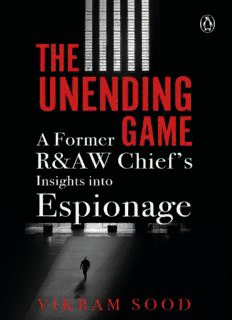
The Unending Game: A Former R&AW Chief’s Insights into Espionage PDF
Preview The Unending Game: A Former R&AW Chief’s Insights into Espionage
VIKRAM SOOD THE UNENDING GAME A Former R&AW Chief’s Insights into Espionage PENGUIN BOOKS Contents Prologue PART I: TRADECRAFT 1. Indispensable Intelligence 2. How Spies Work 3. Spy against Spy or Spy with Spy 4. The Asian Playing Fields PART II: INSIDE INTELLIGENCE 5. State of Surveillance 6. Intelligence Smoke and Mirrors 7. The Triangle: The Terrorist, the Criminal and the Spy 8. Controlling the Narrative PART III: WHAT LIES AHEAD 9. The Other Side of Technology 10. Known by Their Failures 11. Keeping Intelligence Relevant Epilogue Author’s Note Notes Follow Penguin Copyright To my father, who taught me the right values, and Gary Saxena, who moulded me ‘A king shall have his agents in the courts of the enemy, the ally, the middle and the neutral kings to spy on the kings as well as eighteen types of high officials’ Kautilya’s Arthashastra Prologue ‘WAR IS HELL. SPYING IS MUCH, MUCH WORSE. WARS YOU CAN WIN. BUT IN ESPIONAGE THERE ARE NO WINNERS BECAUSE IT NEVER ENDS’ —Intel Wars: The Secret History of the Fight against Terror , Matthew Aid Café du Trocadero, Paris, November 1978 ‘Forget chasing the plutonium route. Uranium is the real McCoy,’ he said to the other man. The two had met for coffee that Sunday morning and then drifted away together towards Avenue Poincaré to their cars. As one of them unlocked his car, the other slipped him an envelope. It had taken years of a furious hunt all over Europe to lay hands on any evidence of Pakistan’s pursuit of nuclearization as the agile Pakistanis moved from Germany to the Netherlands, then to Belgium, France, Switzerland and the UK, shopping for bomb-making equipment. The envelope contained a document that clearly indicated that Pakistan had obtained twenty high-frequency inverters essential for enriching uranium. The first order had been placed through a West German firm—Team Industries. Siddique Ahmed Butt of the Pakistan Embassy had contacted Ernest Piffl, the owner, in 1977 saying that the inverters were required for a textile plant. Piffl placed the order via Weargate, a front company in the UK. Weargate, in turn, placed the order with a subsidiary of Emerson Industrial Controls, a British subsidiary of the US giant Emerson Electricals. The inverters were shipped to Special Works Organization in Rawalpindi in August 1978. The supplies were clearly meant for the Pakistani Army, which was by then in charge of Project 706, initiated by the now-imprisoned Zulfiqar Ali Bhutto. Project 706 was the code name for the country’s clandestine nuclear programme. A hunt that began six years ago was now beginning to show results. Unearthing Pakistan’s nuclear programme was one of the toughest challenges faced by the Research and Analysis Wing (R&AW) in its initial years. Dhaka, 16 December 1971 General A.A.K. Niazi, who was commanding Pakistan’s forces in what was till then East Pakistan, surrendered to Lieutenant General J.S. Aurora. All of India celebrated. The nation of Bangladesh came into being. It was a proud moment celebrated. The nation of Bangladesh came into being. It was a proud moment for the armed forces and for all those who fought that war—Bangladeshi and Indian alike. Some of the tar of India’s defeat in the 1962 Sino-Indian War was washed away. Pakistan had been taught yet another lesson, soon after 1965, and it was hoped that it would settle into the changed geopolitics of the subcontinent, with its Two-Nation Theory drowned in the bloody aftermath of the Dhaka uprising. Eternal peace was now at hand, some naively thought. The R&AW had plenty to celebrate too, after its significant contribution to a major success so soon after its creation in 1968. But there were no victory parades, and no one would light a lamp for the unknown agents, their handlers and their supervisors who had helped in the war. Honours and quiet citations would come later, wrapped in the usual cloaks. For most, that was enough. They had stories to tell their grandchildren. Many in the organization did not even know if the R&AW was involved in the Bangladesh Liberation Struggle, such was the level of restrictive security in those early days. For Rameshwar Nath Kao, the man who led the R&AW to this fabulous success, and his close advisers, it was business as usual. They had other worries, other peaks to conquer, other battles to win. Soon enough, every station brief of the R&AW would have Pakistan’s nuclear plans as the first item of interest. Multan, 20 January 1972 Barely five weeks after the Dhaka surrender and one month after he took over as President of Pakistan, Zulfiqar Bhutto called for a secret meeting under a grand shamiana in Multan. An estimated 400 people were present, including some foreigners. Originally scheduled to be held in Quetta, the venue of the meeting had to be changed because of the rebellious Baloch. Typical of the feudal showman that Bhutto was, everything had to be done in style, even when it was an occasion to ask his nuclear scientists, advisers and supporters, ‘How soon can I have the Bomb?’ ‘Five years,’ some promised. ‘Too late,’ Bhutto would say with a snigger. Till one eager young scientist claimed it could be done in three years. Satisfied, Bhutto took off for Libya to meet his new friend Muammar Qaddafi and cajole him for funds for the Bomb. Bhutto also visited a dozen West Asian countries, including Iran and Saudi Arabia, as well as Egypt, where he played the Islamic card. Obviously, he was preparing for a future where he would be the leader of Pakistan, which in turn would be the leader of the Muslim world, with its own nuclear bomb. Those who were opposed to the nuclear weapon or supported it only
Description: